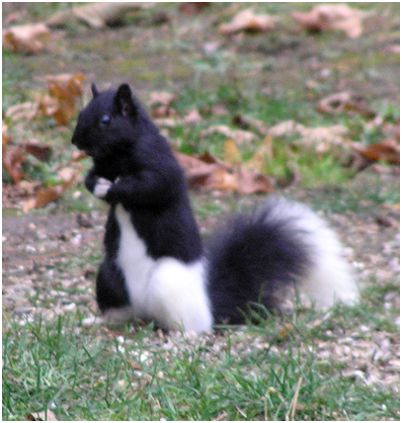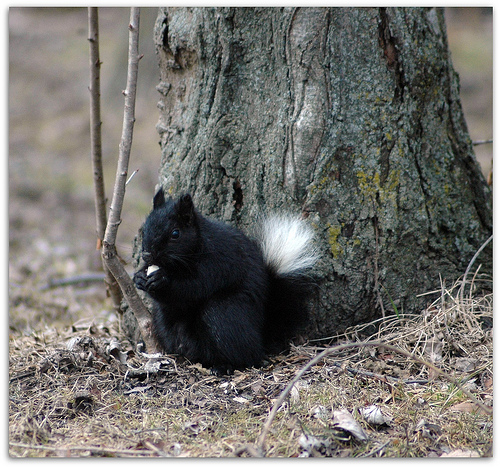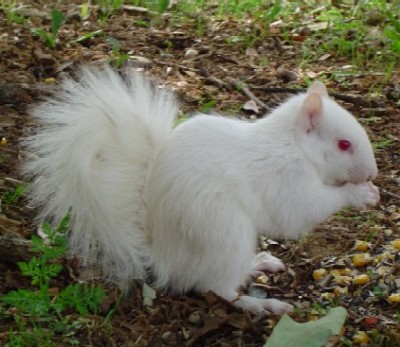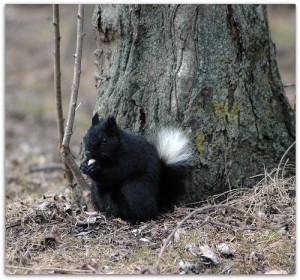Squnks: Piebald Sciurus carolinensis
Posted by: Loren Coleman on August 16th, 2011
What’s going on here? What is a squnk?



An unusual squirrel searches for food beneath a bird feeder at the home of Harry and Alice Hilliard near Sauble Beach, Canada, in 2008. Photo by Kevin Loader.
Photographs are newly under discussion on the Internet of piebald (black and white) squirrels (Eastern gray squirrel, Sciurus carolinensis), taken in High Park area, Toronto, Ontario, Canada.
Considering that Cryptomundo has spent some time discussing both black (melanistic) and white (albino, or near albino, i.e. leucistic) squirrels, what are we to make of these new squnks, that even have photographic evidence?



Anyone have any information on this black & white squirrel population, in terms of how many there are?
Other locations?
For more on past black squirrel and white squirrel postings at Cryptomundo, see: 1, 2, 3, and 4. Plus, see 2006’s Top Ten White & Black Squirrels’ Hot Spots, and Yahoo: “Salt & Pepper Squirrels” #1.
(Idea from a mention by Karl Shuker.)
About Loren Coleman
Loren Coleman is one of the world’s leading cryptozoologists, some say “the” leading living cryptozoologist. Certainly, he is acknowledged as the current living American researcher and writer who has most popularized cryptozoology in the late 20th and early 21st centuries.
Starting his fieldwork and investigations in 1960, after traveling and trekking extensively in pursuit of cryptozoological mysteries, Coleman began writing to share his experiences in 1969. An honorary member of Ivan T. Sanderson’s Society for the Investigation of the Unexplained in the 1970s, Coleman has been bestowed with similar honorary memberships of the North Idaho College Cryptozoology Club in 1983, and in subsequent years, that of the British Columbia Scientific Cryptozoology Club, CryptoSafari International, and other international organizations. He was also a Life Member and Benefactor of the International Society of Cryptozoology (now-defunct).
Loren Coleman’s daily blog, as a member of the Cryptomundo Team, served as an ongoing avenue of communication for the ever-growing body of cryptozoo news from 2005 through 2013. He returned as an infrequent contributor beginning Halloween week of 2015.
Coleman is the founder in 2003, and current director of the International Cryptozoology Museum in Portland, Maine.









The images kind of look photo-shopped. You know, having that “doesn’t it look real”-ness to them.
In Australia, there are “magpies,” crows that are black/white calico. But, I have never seen that in squirrels, anywhere.
Are the three pictures supposed to be of the same individual specimen? Somehow the prominent white belly and leg are missing from the middle image… IMO you should at least be able to see part of the white fur on the leg the way it sits there…
About 15 years in my hometown in Southern Illinois a Black Squirrel turned up. It was almost all black but had tufted ears and the tufts were white, and a small amount of white on the tail, similar to the 2nd photo above. It was the only one we had ever seen and of course someone ended up running over it. It could have been some other kind of squirrel that escaped or something in the area or maybe the black and white squirrels are like the King Cheetah and Black Leopard or Jaguar and just recessive anomalies that occasionally pop up. But I can assure you that even though some of the above photos may be ‘shopped, there are black and white squirrels.
No, it’s definitely not photoshopped. Some of you are highly paranoid. It’s just a color mutation. Would anyone scream photoshop if it were a picture of a black and white mouse or rat? Also, it’s incredibly adorable and I want one!
I’d also say it’s quite obvious that the first two pictures are of two separate black and white squirrels.
There are black squirrels running all over the city of Hamilton, Ohio. See them every day.
Olney is known for having albino squirrels.
I live in the seacoast area of New Hampshire. When we lived in Kensington, we noticed some black squirrels. We moved to Hampton, about 15 minutes away, and I’ve seen black squirrels here, so there is a small population of black squirrels romping around here for sure.
I agree with Averagefoot. People are getting very paranoid about Photoshop. It would be extremely difficult to Photoshop a squirrel to look like that, and even so, why would anyone do it? I could be wrong, but I don’t think there’s a large community of people searching for proof of black & white squirrels. It is simply what it appears to be: a unique genetic (dis)coloration. Also, the first and third photos are of the same squirrel. The middle picture is a different individual, and the photo was clearly taken with a different camera.
Also, love the “squnk” nickname.
Genetic mutation, like Averagefoot said … maybe they live near a lot of skunks and so it’s to help ward off predators, have more time to get food on the ground. There are LOTS of different species of squirrels that share the same parts of America, so all kinds of things can happen I’m sure. Off subject, did you know that outside of primates, rodents are some of our closest relatives?
I lived in Rosslyn DC/VA within sight of the Iwo Jima Memorial in the 90’s. All I saw there were black squirrels. I thought that was just what they had down there. I saw a white squirrel near my house recently. I thought it was my neighbor’s albino ferret til I got up close to it.
Sauble Beach is about a 2 and half hour drive from Huron County, Ontario. There is a sizeable population of white squirrels in certain spots in this area. The catch phrase for Exeter, Ontario, is, “home of the White Squirrel”. These squirrels are a consistent white to dirty white, but have black eyes, and are found with the common black squirrel variety.
The color patches remind me of a pet fancy rat. I wonder if rats and squirrels could breed?
We had one of these hanging around our backyard a couple years ago. I saw it for 2 years in a row and then nothing. I took a few photos but never got anything real close up. Ours had white on its tail and was black otherwise. It is a known genetic mutation. We also had a leucistic blackbird last year. Crazy looking, but both of them are known to science.
I’ve only just stumbled across this site when researching piebald squirrels & found the above discussion, I know it’s a couple of years old now but hope it’s still viewed.
I’m from Ipswich, England. I’m sure I saw a black & white squirrel a few weeks back. I was sitting in my car, in the car park at work, when I spotted a black & white creature. Initially I thought it was a small cat, but it ran like a squirrel, sitting on hind legs when it came to a stop. It eventually ran up a tree & out of my vision. A colleague of mine has seen it too.
In this part of England we only have grey squirrels, which eradicated our native reds, some time back. How could a piebald have come about?